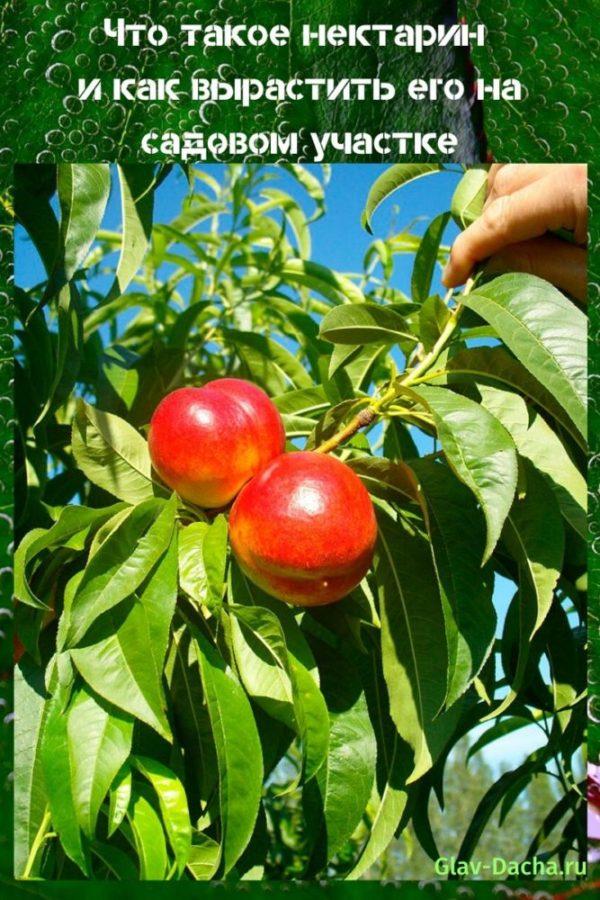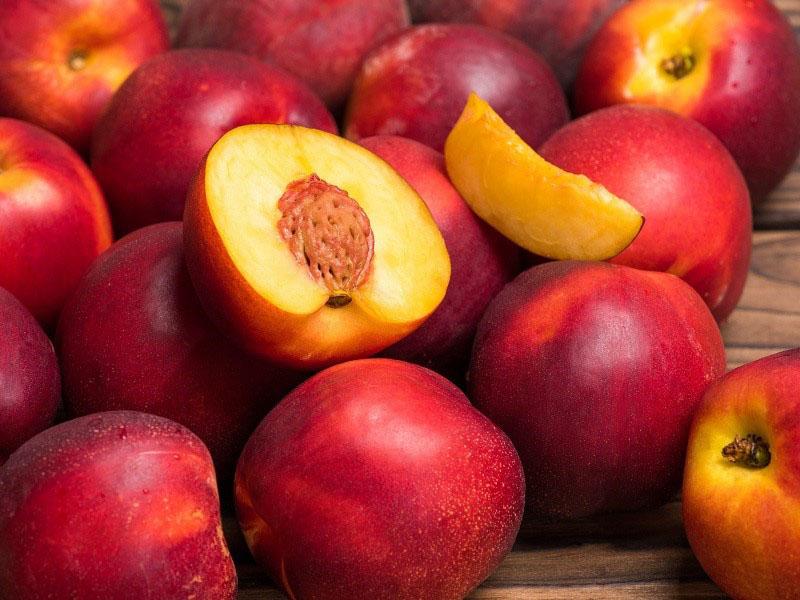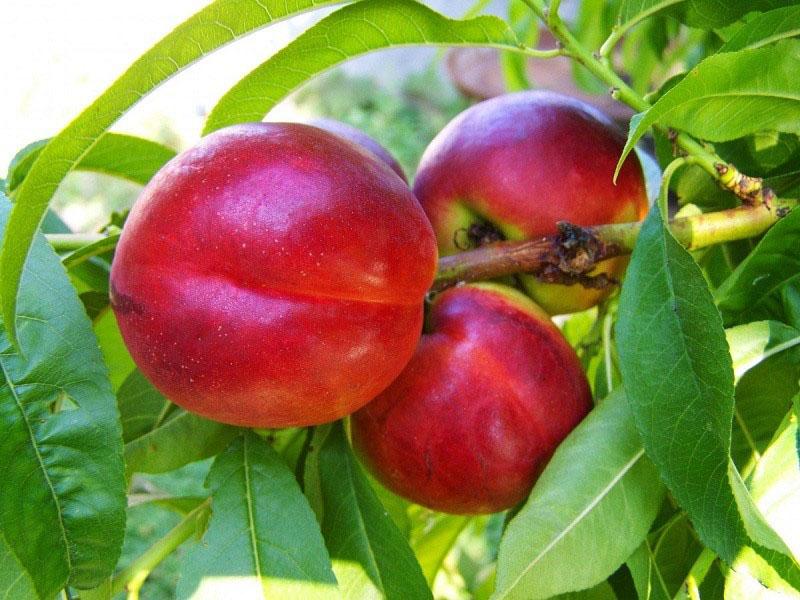What is nectarine and how to grow it in the garden
 Until recently, we did not know what nectarine is. Currently, thanks to the efforts of breeders, a large number of varieties are known that can withstand low temperatures, which makes it possible to significantly expand the distribution area of this crop. Now every summer resident who has observed all the growing conditions can boast of a rich harvest of nectarine at the end of the season.
Until recently, we did not know what nectarine is. Currently, thanks to the efforts of breeders, a large number of varieties are known that can withstand low temperatures, which makes it possible to significantly expand the distribution area of this crop. Now every summer resident who has observed all the growing conditions can boast of a rich harvest of nectarine at the end of the season.
What is nectarine

Even an ordinary peach sometimes spontaneously produces smooth fruits without a velvet fluff.
Botanical description of culture
 The fruit tree reaches a height of 5-7 meters and enters the flowering phase after the first leaves appear. The branches are cluttered with fragrant pink buds with an amazing decorative look. The spreading crown acquires a diameter of 3-4 meters. The foliage is large and elongated, lanceolate.
The fruit tree reaches a height of 5-7 meters and enters the flowering phase after the first leaves appear. The branches are cluttered with fragrant pink buds with an amazing decorative look. The spreading crown acquires a diameter of 3-4 meters. The foliage is large and elongated, lanceolate.
Fruits form on branches that are more than a year old. Gradually, the fruit goes from a yellow-green color to a bright orange hue. In a favorable climate and proper care, the diameter of the fruit can reach 4-5 cm, and the average weight is from 120 to 150 grams. The fruit is recognized by the smoothness of the skin, the absence of villi. There are two types of pulp: fibrous (table varieties) and gristly (suitable for canning).
Features of the growth of nectarine
 What is nectarine became known in China back in the 14th century; the culture has been cultivated there for 2000 years. In Europe, this plant became popular only in the 20th century. The reason for this was a breakthrough in genetics and the development of large-fruited varieties. At present, the area of nectarine cultivation has expanded significantly after the selection of regionalized varieties intended for growing in the northern regions.
What is nectarine became known in China back in the 14th century; the culture has been cultivated there for 2000 years. In Europe, this plant became popular only in the 20th century. The reason for this was a breakthrough in genetics and the development of large-fruited varieties. At present, the area of nectarine cultivation has expanded significantly after the selection of regionalized varieties intended for growing in the northern regions.
Conditions for growing nectarine in Ukraine, under which the tree gives the highest and highest quality yield:
- Sandy loam or loamy soils that retain moisture and prevent rot. It is important to provide a neutral acidic environment and sufficient nutrients.
- The summer lasts at least 150 days, while the nectarine must be in the sun for at least 8 hours a day.
- Optimum temperature conditions in winter. An adult plant can withstand temperatures of -32 degrees, but young seedlings can die even at -2. The tree is recommended to be planted only in warm regions, since it is quite difficult to grow nectarine in the north and achieve a good harvest.
- Favorable climate. Frequent precipitation and prolonged stay in the shade are considered destructive for nectarine.
The successful development and fruiting of the culture will be facilitated not only by competent planting and timely care, but also by a properly selected variety, depending on the climate of the region.
Planting nectarine
 The main task of a gardener who wants to get a rich harvest is to provide quality planting and nectarine care.If the planting recommendations are not followed, problems may arise with the rooting and development of the plant, so it is better to take this process responsibly.
The main task of a gardener who wants to get a rich harvest is to provide quality planting and nectarine care.If the planting recommendations are not followed, problems may arise with the rooting and development of the plant, so it is better to take this process responsibly.
Boarding times and seat selection
In the southern regions, it is recommended to plant nectarine in the autumn. In northern areas with harsh winters, plan planting in spring.
When choosing a landing site, it is important to consider the following recommendations:
- give preference to areas with loamy or sandy loam soils, unsuitable for nectarine - heavy clay soils;
- the groundwater level should not be close to the earth's surface;
- not the best predecessors on the site - nightshade, melons, Strawberry, clover;
- a south-facing area is suitable, provided that other trees do not block the sunlight.
You should not plant a crop next to a peach, as this will increase the risk of fungal infections on trees.
Seedling selection and planting technology
 When choosing planting material, pay attention to the variety: it must be adapted to the given area. It is better to buy annual seedlings with a well-developed root system without dry and rotten roots, healthy green bark from the inside and high-quality grafting without sagging.
When choosing planting material, pay attention to the variety: it must be adapted to the given area. It is better to buy annual seedlings with a well-developed root system without dry and rotten roots, healthy green bark from the inside and high-quality grafting without sagging.
The autumn planting algorithm includes several stages:
- Prepare a pit for disembarkation 2-3 weeks before planting. The size of the hole is on average 0.7x0.7x0.7 m. Place a wooden stake about 150 cm high in the center.
- Mix the top layer of soil with 150 g of superphosphate, 10 kg of decayed compost. Pour half of the resulting mass to the bottom of the pit.
- Place the seedling in the groove, spread the roots and fill the hole with the remaining potting mix. In this case, the vaccination site should be at the level of 30-40 mm from the ground level.
- Tamp the earth and pour 4-5 buckets of water.
- Tie the seedling to a peg, loosen the soil and cover with a layer of mulch.
When planting a seedling in the spring, start preparing the pit in the fall.
Culture care
 Caring for nectarine includes the implementation of agrotechnical techniques aimed at ensuring the survival of the tree after planting and creating favorable conditions for growth.
Caring for nectarine includes the implementation of agrotechnical techniques aimed at ensuring the survival of the tree after planting and creating favorable conditions for growth.
Watering and pruning
 Moisten the soil moderately, based on weather factors, soil type and plant age. On average, you need 40-50 liters once a week. The soil should dry out between waterings.
Moisten the soil moderately, based on weather factors, soil type and plant age. On average, you need 40-50 liters once a week. The soil should dry out between waterings.
Nectarine care also includes pruning, preventive and formative. The first pruning of a seedling planted in autumn is carried out in the spring before the start of sap flow in April.
Principle of nectarine crown formation after winter:
- Remove all broken, frostbitten branches, as well as those that show signs of disease.
- Choose two developed shoots growing side by side on the skeletal branch, and cut off the rest.
- The one that is closer to the end should be shortened by 8-10 buds.
- Cut off the second branch, which is near the trunk, leaving only 2 buds on it - an shoot will grow from it, which will bear fruit next season.
- Thus, add 2 skeletal branches every year.

Carry out sanitary pruning as needed in the summer and spring in the presence of dry and diseased shoots.
Top dressing
 In April, to build up green mass, to enhance the growth of nectarine, feed with fertilizers based on nitrogen. In late spring and summer, apply twice potash fertilizers, and then fertilize with organic tinctures at intervals of 2 weeks. The last procedure is 2 weeks before harvest.
In April, to build up green mass, to enhance the growth of nectarine, feed with fertilizers based on nitrogen. In late spring and summer, apply twice potash fertilizers, and then fertilize with organic tinctures at intervals of 2 weeks. The last procedure is 2 weeks before harvest.
While preparing the nectarine for winter, additionally feed the plant with superphosphate and humus.
Preparing for winter

Before the onset of frost, it is important to have time:
- remove the area from dry leaves, branches;
- water the plant abundantly;
- carry out additional complex feeding;
- lay mulch in the form of sawdust, peat;
- process the trunk and base of the skeletal branches with lime;
- drive three slats around the tree and wrap with wire;
- overlay the frame with spruce branches and agrofiber;
- tie everything with twine so that the structure does not rip off due to the gusty wind.
 To protect the seedling from severe frosts, you need to install two pegs on both sides of the plant and put a bag on them, the lower part of which should be sprinkled with plenty of earth.
To protect the seedling from severe frosts, you need to install two pegs on both sides of the plant and put a bag on them, the lower part of which should be sprinkled with plenty of earth.
Diseases and pests
 A culture in the absence of optimal conditions and proper care can get sick with moniliosis, powdery mildew, clotterosporia, and also catch the curl virus. Nectarine was also chosen by pests: peach aphid, miner moth, scale insect.
A culture in the absence of optimal conditions and proper care can get sick with moniliosis, powdery mildew, clotterosporia, and also catch the curl virus. Nectarine was also chosen by pests: peach aphid, miner moth, scale insect.
To protect the plant from fungal, bacterial diseases and pests, it is necessary at the time of flowering to treat it with a combined solution of Colicarbacin (40 g), colloidal sulfur (150 g) and a bucket of water. Carry out a similar procedure during the fruiting period in the presence of initial symptoms of fungi and insect infestations.
Many gardeners know what nectarine is and want to grow it in their summer cottage. To make your dream come true, you need to choose the right variety and take into account all the subtleties of planting and important points of care. Then the heat-loving trees will delight you with the beauty of their flowering and a generous harvest of delicious fruits for a long time.